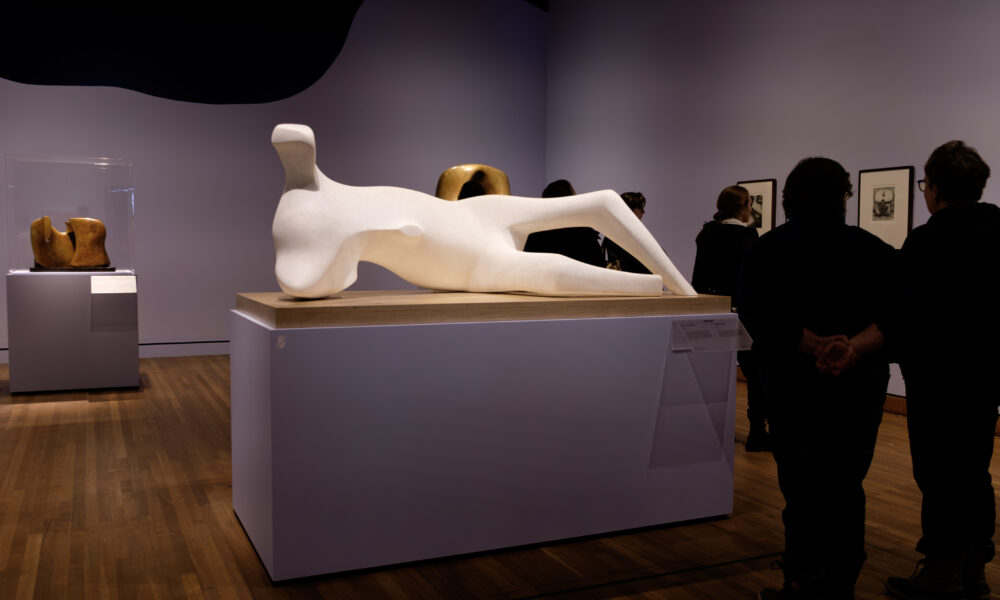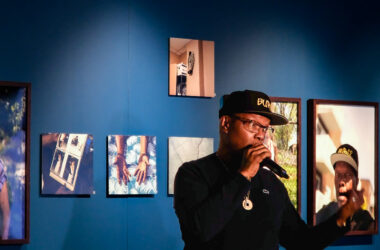The exhibition is not organized temporally. The rooms move from bones to stones, from landscapes to recreations of O’Keeffe’s and Moore’s studios. It weaves and jumps through the 20th century, from New York to Mexico to Scotland, from gastropod shells to irises to pelvises.
Georgia O’Keeffe and Henry Moore: Giants of Modern Art, organized by the San Diego Museum of Art and the Montreal Museum of Fine Arts, and curated by Anita Feldman and Iris Amizlev, opened in Montreal on Feb. 10.
The exhibition has a certain preoccupation with twos: O’Keeffe and Moore, inner and outer, sculpture and painting, earthy bodies and human bodies. O’’Keeffe’s paintings feature objects in pairs: Feather and leaf. Sawbone and fungus. Moore’s sculptures often function simultaneously as frames and framed—you can look at them, but you can also look through them.
And if you stand at the right angle, you can see O’’Keeffe’s paintings through Moore’s sculptures. The exhibition space is set up to reflect the art inside; Moore-like keyholes in one room’s walls stretch partway to the ceiling, allowing space to complete the picture. Another room is divided with jagged, cliff-like shapes jutting out from either side—cliffs that could exist in an O’Keeffe painting.
Recreations of the artists’ studios sit roughly in the middle of the exhibition, not at the start. Moving through the exhibition, it becomes clearer why. O’’Keeffe and Moore focused on objects that had lives before they did: Bones, mountains, shells. The artists are perhaps placed partway through the journey because the story started long before either of them lived.
Where does the body end—and does it end at all? Moore’s sculptures can be read as reclining bodies, but also as landforms, dipping in and out, curving at parts. One of O’Keeffe’s paintings—perhaps my favourite in the exhibition—Barn with Snow, depicts a winter landscape at Alfred Stieglitz’s farm. The Gallery label includes a quote from O’’Keeffe, written about Gaspésie: “[T]he beautiful barns looked old, as if they belonged to the land.” She visited Quebec in 1932 and became enamoured with the Gaspé Peninsula. Far from her New Mexico studio, she encountered another landscape at once soft and rolling; jagged and foreboding—land that doesn’t seem to finish where bones and barns begin. Barriers, beginnings, and endings often blur within the exhibition. Perhaps they don’t exist at all.
Zooming in and out, the story changes. O’Keeffe and Moore look at objects so closely that they become something else entirely: Moore’s Working Model for Oval with Points seems to be a study of peculiar shape, something not often found in nature—but was inspired by observing the inside of an elephant skull. A point existing inside a shell.
O’Keeffe’s From the River Pale (1959) derived inspiration from a bird’s-eye view of rivers snaking through landscapes (with the rapidly rising popularity of air travel likely in mind). I initially thought it was an up-close shot of a leaf. But O’Keeffe modelled the shape and flow of the rivers from a tree branch. A close view of a branch becomes a wide view of a landscape: Both are equally detailed.
If the whole exhibition is considered to be the shell, then the paintings, sculptures, sketches, and perhaps even museum-goers, become the invisible machinations inside. The curvature of bone inside the elephant skull; the careful folds of the jack-in-the-pulpit. Exhibition spaces made by their art, art made by exhibition spaces; museums made by people, people made by museums.
Digital-media conceptions of learning often result in information overload at high speed. Stories are everywhere, all of the time, accessible immediately. But perhaps a greater volume of knowledge can be procured from single sources—taking the time to know something you care deeply for. O’Keeffe and Moore focus intently upon certain objects unfolding over time. Bones and flintstones take time to record their stories and emerge. Flowers take time to unfurl. O’’Keeffe and Moore take the time to stop and look.
“When you take a flower in your hand and really look at it, it’s your world for the moment. I want to give that world to someone else. Most people in the city rush around so, they have no time to look at a flower,” O’Keeffe wrote, her quote featured on the gallery walls. “I want them to see whether they want to or not.”
Georgia O’Keeffe and Henry Moore: Giants of Modern Art runs until June 2, 2024. Tickets are available online or in person at the MMFA.









